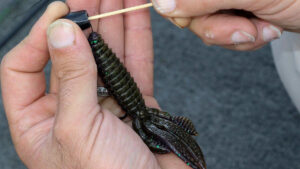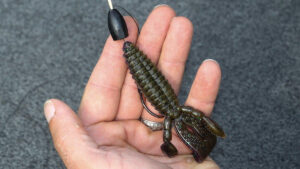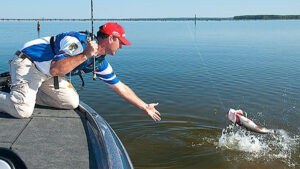Those of us that grew up before rubber bobber stops learned to peg flipping weights with toothpicks, but quickly ditched those bass fishing tricks of our grandfathers and uncles when rubber pegs were developed. Todd Faircloth, however, makes a legitimate case for why he opts to peg his Texas-rigged weights with the old-school ‘pick. Weight positioning, bait mobility and better hookups are his main objectives.
For his heavier flipping, pitching and punching rigs, the pro from Jasper, Texas actually uses a piece of toothpick at the top of his weight and another at the bottom. This allows him to create strategic space by positioning his sinker slightly above the hook without worrying with unwanted sliding.

“I like to have about a quarter-inch gap between the bottom of my weight and my plastic,” Faircloth said. “I feel like it makes it more lifelike, especially when you’re ‘tickling’ the bottom of the mats where you pick the bait up and shake it underneath the mat.
“It’s a lot simpler too; you have a toothpick versus rigging a bobber stopper. But I don’t want that big weight crashing down on my plastic because it’ll wear it out, and I’ll eventually have to change it out because my bait won’t stay up on my hook.”

When it’s time to remove a toothpick peg — either retying a rig or simply replacing a piece that’s seen too much action — Faircloth has two methods. He can usually reach the bottom piece with a hook point, but the top one requires a gentle shove with a thin finishing nail.
“You can also cut a piece of fine copper wire to punch the toothpick back out,” Faircloth said.
The easy removal bears subtle benefit to his time efficiency because progressing down a bank might take him in and out of the cover requiring a pegged sinker.

“If I can fish a bait with my sinker sliding up and down my line, I feel like I get more bites,” Faircloth said. “I don’t peg my weight unless I have to and there are certain situations where you have to; like flipping mats and flipping heavy buck brush.”
Notably, Faircloth said that pegging his weight above the hook actually improves his hookup percentage by eliminating a common heartbreak.

“If the weight is not crunched down on the bait, the fish isn’t going to have as much leverage to throw the bait,” he said.













